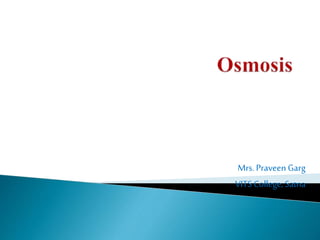
Osmosis
- 1. Mrs. Praveen Garg VITS College, Satna
- 2. “Osmosis is a process by which the molecules of a solvent pass from a solution of low concentration to a solution of high concentration through a semi-permeable membrane.”
- 3. Osmosis: The process of moving of solvent particles across a semipermeable membrane from a dilute solution into a concentrated solution to equalize concentration. The complete process does not require energy in order to take place. For example, the absorption of water molecules from the soil through the roots of the plant. Diffusion: The process of moving particles from a region of higher concentration to the region of lower concentration until equilibrium is reached. Simple diffusion does not require energy in order to take place; however, facilitated diffusion requires ATP. An example of diffusion of the perfume sprays into the air by spreading the aroma.
- 5. Osmosis Diffusion It is limited only to the liquid medium. Requires a semipermeable membrane. Depends on the number of solute particles dissolved in the solvent. Requires water for the movement of particles Only the solvent molecules can diffuse. The flow of particles occurs only in one direction. Occurs only between similar types of solutions. . Occurs in liquid, gas and even solids. Does not require a semipermeable membrane. Depends on the presence of other particles. Does not require water for the movement of particles. Both the molecules of solute and solvent can diffuse. The flow of particles occurs in all the directions. Occurs between the similar and dissimilar types of solutions.
- 6. There are three different types of solutions: Isotonic Solution Hypertonic Solution Hypotonic Solution An isotonic solution is one that has the same concentration of solutes both inside and outside the cell. A hypertonic solution is one that has a higher solute concentration outside the cell than inside. A hypotonic solution is the one that has a higher solute concentration inside the cell than outside.
- 7. Osmosis is of two types: Endosmosis– When a substance is placed in a hypotonic solution, the solvent molecules move inside the cell and the cell becomes turgid or undergoes deplasmolysis. This is known as endosmosis. Exosmosis– When a substance is placed in a hypertonic solution, the solvent molecules move outside the cell and the cell becomes flaccid or undergoes plasmolysis. This is known as exosmosis.
- 8. Osmosis affects the cells differently. An animal cell will lyse when placed in a hypotonic solution compared to a plant cell. The plant cell has thick walls and requires more water. The cells will not burst when placed in a hypotonic solution. In fact, a hypotonic solution is ideal for a plant cell. An animal cell survives only in an isotonic solution. The osmotic flow can be stopped or reversed, also called reverse osmosis, by exerting an external pressure to the sides of the solute. The minimum pressure required to stop the solvent transfer is called the osmotic pressure.
- 9. Osmotic pressure is the pressure required to stop water from diffusing through a membrane by osmosis. It is determined by the concentration of the solute. Water diffuses into the area of higher concentration from the area of lower concentration. When the concentration of the substances in the two areas in contact is different, the substances will diffuse until the concentration is uniform throughout.
- 10. Osmosis influences the transport of nutrients and the release of metabolic waste products. It is responsible for the absorption of water from the soil and conducting it to the upper parts of the plant through the xylem. It stabilizes the internal environment of a living organism by maintaining the balance between water and intercellular fluid levels. It maintains the turgidity of cells. It is a process by which plants maintain their water content despite the constant water loss due to transpiration. This process controls the cell to cell diffusion of water. Osmosis induces cell turgor which regulates the movement of plants and plant parts. Osmosis also controls the dehiscence of fruits and sporangia. Higher osmotic pressure protects the plants against drought injury.